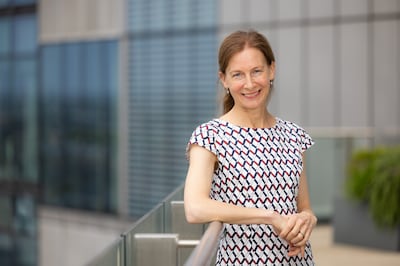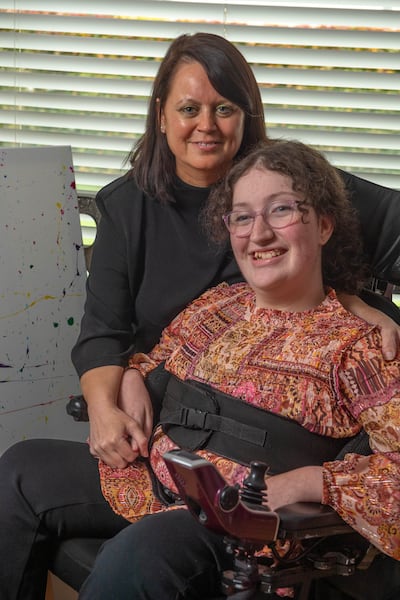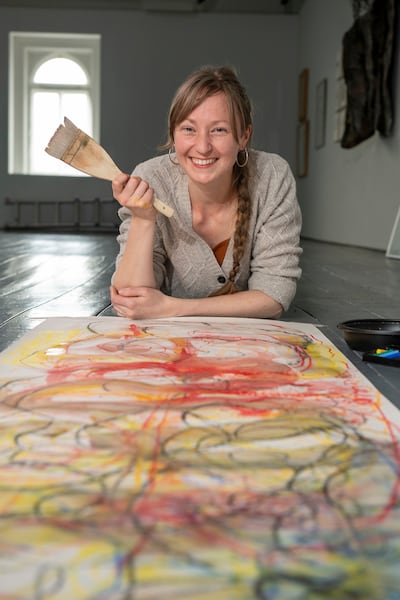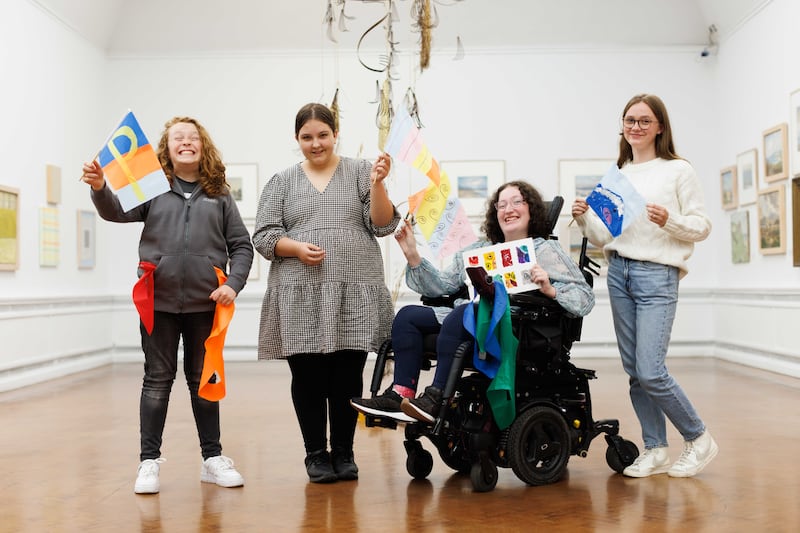Teenagers living with lifelong physical health conditions are cut off from many social activities that their peers take for granted, compounding their sense of loneliness and stigma.
If they are from a disadvantaged background, research shows “they are three times more likely to be hampered by their condition”, says Helene Hugel, founder and chief executive of Helium Arts, a charity intent on removing their barriers to participation in communal creativity.
By providing free local workshops in accessible buildings, with a paramedic at every session, the organisation is catering for youngsters for whom it may be the only activity they can attend, without a parent, outside school or the health services. What Helium Arts (helium.ie) offers is “definitely not” art therapy but it “absolutely” has therapeutic benefits, she says.
While we are about quality art, we are not always aiming for that perfect piece framed on a wall
— Helene Hugel, Helium Arts
Art therapy is focused on clinical outcomes, whereas the organisation she founded in 2010 champions participatory art in the community and the social connections this fosters. It also celebrates the work of these young people as artists with public recognition, which it is doing with the Helium Arts Showcase in various locations in Cork, Galway, Limerick and online during November and December.
Actor Armie Hammer resurfaces as host of celebrity podcast
Heart-stopping Halloween terror: 13 of cinema’s greatest jump scares
Doctor Odyssey’s core message: just imagine Pacey from Dawson’s Creek holding you tight and saying, ‘Shhh, it’s okay’
Conor Niland’s The Racket nominated for William Hill Sports Book of the Year

The now almost 25 professional artists who work with the charity also model a career in the arts and in creative industries for these young people, says Hugel, who is originally from upstate New York and now living in Mullingar, Co Westmeath. Visual art, “but in a very multi-disciplinary way”, is their field.
[ How can a person know what kind of therapy they need?Opens in new window ]
“Some of our artists are skilled animators, others performers, but there is always a making element. We are all about the process,” she explains. “While we are about quality art, we are not always aiming for that perfect piece framed on a wall.”
In its early years, Helium Arts focused on working with children in Dublin hospitals, but changed tack in 2019 as the health service shifted towards more care in the community. There were fewer children with lifelong physical conditions spending lengthy time in hospitals, although many were still travelling from regional centres to Dublin for outpatient appointments.
“We decided we have to go where they are and reflect the care in the community,” says Hugel. Helium Arts directed all its resources to a new way of working through regional creative hubs, with the intention of returning to Dublin as funding allows. “We do still work in hospitals but it is in the outpatient space” – currently in the paediatric units in Cork, Limerick, Galway and Mayo. Waiting times there can be long and stressful, she points out, so artists are running activities which are about relaxation, but also about enabling children to pass time “in a real quality way, so you don’t feel time pass”.
Hospital staff feedback is testament to the positive impact. One receptionist remarked that she hadn’t had one complaint all day, Hugel laughs. “There is such a level of calm and quiet.”
Clinicians also say they can do more with their patients in a shorter period because they come in to them relaxed, and time doesn’t have to be spent settling them. “They are not anxious and are willing to engage – both the children and the parents.” It means, along with all the other benefits, that the art can help increase efficiency on the clinical side.
“We meet everyone in outpatients’,” she says. So families who might not have considered that their child would be interested in group art participation may discover it there and sign up for a community programme. These are operating in eight locations in Limerick, Cork, Galway and surrounding counties.
Running on an annual budget of €880,000, by the end of 2023 Helium Arts will have reached 3,000 children and teenagers over the year, mostly through hospital outpatient departments. However, about 300 of those will have been involved in more sustained work in the community hubs and others will have participated in online programmes. Currently the remote programmes for younger children are oversubscribed, but there are places for teenagers.
[ What’s making you happy? Swimming in the nip, art therapy and singing at MassOpens in new window ]
Evaluation of the work is conducted on an ongoing basis. While the increased wellbeing of children taking part in community programmes was expected, what “stunned” staff, says Hugel, is the evidence of the lift it gives parents too. A study showed that the wellbeing of participants’ parents went from below-average wellbeing at the outset of a programme to one point shy of high wellbeing afterwards, she reports. “I think it’s relief because, of course, when your child is happy, you are happy – and when you’re happy, your child is going to be happy.”
Participant: ‘Really express myself’
Isolation and anxiety have been the biggest struggles in recent years for Ruth Cotter (14), who has spina bifida hydrocephalus and scoliosis, and is paralysed from the waist down.
“I went through horrible back pain for years, then I had the surgery,” she says of the spinal rods that were fitted when she was 10. “I was in recovery for months after that and then we went straight into Covid. That was quite a lot of isolation and not seeing people.”
I feel I can really express myself through art and my creations. I am confident in my art and what I make and whatever method I use
— Ruth Cotter, workshop participant
It was “quite a difficult time for me”, says Ruth, an only child, who lives with her parents Annette and Timothy Cotter in Fermoy, Co Cork. But when she spotted a notice advertising a Helium Arts workshop on the wall of the outpatients department in Cork University Hospital (CUH) and told her parents it was something she would like to do, it heralded the start of a positive change.
“I have always been interested in art and creative science and activities,” she says. Since attending that first workshop at Mayfield Arts Centre in Cork city two years ago, she has been involved in other camps during the school holidays and attends monthly meet-ups. At home, “I have sketch books that I am always drawing in and working on.
“I feel I can really express myself through art and my creations. I am confident in my art and what I make and whatever method I use.” For her it “can be like an escape; therapeutic and relaxing”. She also enjoys the company of other teenagers she has met through Helium Arts, who, like her, are coping with lifelong physical conditions and share an interest in art.

“We would find that we had other things in common. Some of them are wheelchair users as well. It is nice to have that friendship with others that relate to me and my experiences.” She often encounters physical barriers to participation in activities but that is not a problem with Helium Arts.
“Accessibility can be hard to find. I use a power wheelchair and it’s even harder,” says Ruth of the electric wheelchair, which gives her independence and travels at up to 10km/h. But it doesn’t access footpaths more than 7.5cm (three inches) high, which is extremely restricting.
In a three-day Halloween half-term camp this week, the group will be focusing on completing work to exhibit in the Helium Arts Showcase, in St Peter’s Arts Centre, Cork city, from December 7th to 22nd.
“We were given different methods of creating and we got to choose what we would like to do, what we would like to have shown at the showcase. I am doing a lot of paintings and drawings.” There is also collaborative work in which the group are painting on large scrolls.
Mexican artist Frida Kahlo, who struggled most of her life with ill-health and chronic pain after contracting polio at age six and then being very badly injured in a bus accident at 18, is a role model for Ruth.
“There are definite similarities between me and Frida Kahlo – similar pain and similar art work. She created art representing her pain, and I think she is inspiring.”
Ruth will be doing her Junior Cert next June, “but when I leave school, art is something I would definitely like to do in some way. I do like drama as well,” she adds. “I would like to do something creative like that.”
Parent: ‘Fabulous reassurance’
Annette and Timothy Cotter had tried to find children’s art sessions for their daughter over the years but they were never suitable.
“It was just great that this came along because it covered all her needs,” says Annette of Helium Arts. The presence of a paramedic “gives fabulous reassurance from a parent’s perspective. We can go off and do something for a couple of hours. It’s a bit of respite as well.” In addition to the artist leading the session, there are volunteers available to fetch things for Ruth, who has a full-time special needs assistant at school.
[ Students make a show of how art can help with occupational therapyOpens in new window ]
Annette was told that at the end of one session, all the participants were asked for one word to describe the day, and Ruth said “free”. “I thought that was very powerful,” says Annette, who can see the benefits it brings their only child.
I see how Ruth is for days and weeks after the workshops. It’s like she is carrying a lighter load
— Annette Cotter, parent
“Ruth would have a lot of anxiety, [with] her condition, hospital appointments, equipment breaking down – apart from the general teen challenges. It really helps in terms of her anxiety.” As a family, “it gets us engaging a bit more because we talk about the art afterwards”. It’s a steep learning curve in art appreciation for Annette, who says she is trying to educate herself to support Ruth.
The pair go on trips to the Crawford Art Gallery in Cork city and made a memorable visit to the Van Gogh immersive exhibition in Dublin. After Ruth had the major surgery to insert spinal rods, “she became a bit withdrawn, and we can see her coming back”. With just the three of them in the house, there’s all the more need for her daughter to meet other people, she says. But socialisation is not easy. If her friends at school are planning some outing or activity, it is not always something Ruth can attend, explains Annette, whether that’s due to inaccessibility of the venue or that she needs to be home for personal care.
“It can become isolating from that perspective. I am really grateful to Helium Arts. I see how Ruth is for days and weeks after the workshops. It’s like she is carrying a lighter load.”
Artist: ‘Building relationships is key’
Eco-social artist Ashleigh Ellis (36), facilitates “arts while you wait” in the paediatric outpatients’ department of CUH.
The waiting room has been transformed into an art studio, with the wall under a long stretch of window painted in blackboard paint. She has chunky washable paint markers and also washable crayons that youngsters can use to draw on the windows above the wall.

“The whole space is a canvas. It’s quite transformative of the atmosphere” – even for those who just want to sit and watch. “Every day I have families thanking me, the nurses too.”
As Helium’s Cork creative hub artist, working both in the hospital and with the community team, she usually spends three mornings a week at CUH. While her time there is about “relieving anxiety in that moment and making it a creative and fun place”, the work at monthly, two-hour meet-ups for teenagers aged 13-15 is more consistent, with friendships developed within the group. The teenagers have a variety of physical conditions, and some might have additional needs, but Helium’s workshops and holiday camps are designed to be inclusive and can be adapted as necessary.
They get a lot from expressing through their art and also being in a non-judgmental space where they are fully accepted by themselves, by others, by the host facility
— Ashleigh Ellis, artist
“You meet every young person on their own terms. You can read whatever you like about them, but when you meet them it can be very different. Building relationships is key. We keep the groups quite small; eight is our max, and we could go lower if there are very high needs.
“At the beginning they can come in with a lot of anxiety, and by the end they are usually very positive.” She observes how they might chat a lot to friends during the session and be excited to show their parents what they have been doing when they come in. They usually go out happy “and they are returning, time and time again”, which is perhaps the ultimate affirmation of the value of the sessions.
“They get a lot from expressing through their art and also being in a non-judgmental space where they are fully accepted by themselves, by others, by the host facility,” she says.

Unlike school, where they might feel their work has to meet a prescribed standard or look a certain way, here it’s about self-expression and experimenting. “Taking risks and seeing what happens if… and celebrating that.
“They are really flowering creatively, and creativity is so needed in the world,” she adds. “I see they are gaining a sense of empowerment.”





